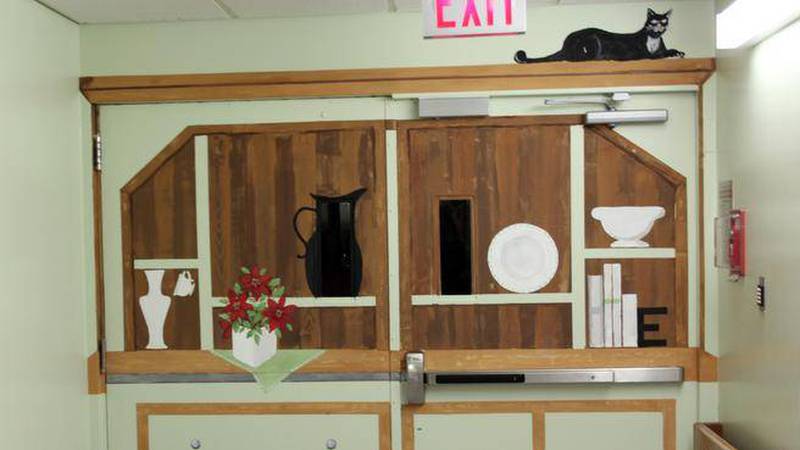 |
| Before. |
The secure exit doors inside the third-floor dementia unit at the QEII’s Veterans Memorial Building once appeared imposing and uninviting. Now the doors resemble a warm book shelf in an inviting living room, complete with images of a flower vase and a cat perched on top.
The team on the special care unit, known as Cedar Crest, received a QEII Foundation Comfort and Care grant last fall. Wanting to help wandering veterans, they had a mural painted on the unit’s doors.
“It makes things seem homier,” says Kathy Ward, a recreation therapist at the QEII who works with veterans in the unit.
Cedar Crest is home to 25 veterans of the Second World War and the Korean War. With most of the veterans over the age of 90, Kathy says she immediately witnessed the mural’s power on the unit’s residents. Instead of rattling the door in frustration like he did in the past, one individual is now spending time looking at the mural. The exit door is now so well camouflaged that visiting family members have even had to ask staff where the door is to leave.
“Wandering is a behaviour commonly associated with dementia,” says Emily A’Court, interprofessional clinical leader at the QEII’s Veterans Services. People with advanced dementia often pace, explore or try to find a way to exit their surroundings. Whether they are looking for family members or trying to go home, they often become upset and anxious when they find a secure door and don’t understand why it won’t open.
Kathy learned through research that several nursing homes have turned to painting murals of familiar pieces of furniture, such as cabinets and cupboards on the doors to help them blend in with the environment.
“The staff notice they do not have to be at the door re-directing veterans,” says Kathy. “The mural also decreases fears and upset behaviour, and it reduces the risk of falls and injuries.”
Previously, staff worried that veterans lingering at the door would be struck by or leave through a door when it is opened.
After deciding on an appropriate design, Emily set to work on the mural. At the time, she was taking a course in dementia care and completed the mural as part of her studies. For six hours one Saturday, Emily painted the bookshelf while veterans looked on curiously, some even helping by holding supplies.
As part of the project, another mural is being painted on a wall near the unit’s team station. Artist Maria Boutilier is creating a calming scene that includes water, a lighthouse, seagulls and purple lupine flowers. A frame will be painted around the mural to make it look more like a hanging painting. The hope is that this will help change behavioural activities amongst veterans who are prone to removing paintings from the walls. Plans are also underway to use a mural to disguise a fire alarm with the hope that the design will prevent residents from pulling the alarm.
Ten years ago, the QEII Foundation started providing Comfort and Care grants for projects that typically would not receive funding from the operating or capital budgets, but showed that they would enhance care to patients, veterans, clients and their families.
“As recreation therapists we’re always looking for creative, non-pharmacological ways to manage behaviours,” says Emily. “We’re trying to create a therapeutic environment.”








